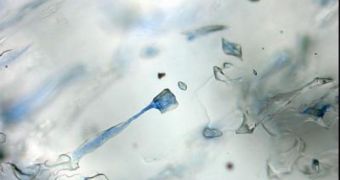Biologists recently published a study depicting for the first time an amazing ability that sea-ice algae have – that to engineer their icy homes in any way they see fit to ensure their survival.
This is a critical ability both for them and a large number of other species living in the same habit. AS far as the Arctic Ocean goes, these types of algae are the first ring in the local food webs.
Anything that happens to them therefore has widespread ramifications. Despite being in the spotlight for such a long time, researchers had no clue that the microorganisms could literally sculpt microscopic channels and pores in ice.
In order to do so, they use the same gel-like mucus that is usually employed in protecting their colonies against temperatures that dip to minus 10 degrees Celsius, and even lower.
The channels and pores the algae can create are then used by other species of microorganisms as well. In this way, one species builds a hone for many others, allowing them to survive in the harsh climate of the Arctic too.
According to investigators, the fact that algae have this ability is good news. Given the creeping influence of global warming at the North Pole, it's a good thing that these organisms will survive.
If they don't, then hungry fish and shellfish that depend on them for their existence will cease to exist as well. The collapse of sea-ice algae populations would literally be a disaster for this ecosystem.
On the other hand, University of Washington professor of oceanography Jody Deming believes that the organisms may be contributing to thinning the already-unstable Arctic ice sheets, and making them more vulnerable to seasonal melting.
However, the expert admits that the extent to which the microorganisms affect the ice is still unknown, and that it merits further investigations. Deming is also the co-author of a paper on the issue, that appeared in the March 1 issue of the journal Proceedings of the National Academy of Sciences.
The new study was funded by grant money secured from the US National Science Foundation (NSF).
Some experts believe that these algae may in fact prevent the ice from melting too fast during the Arctic summer, by plugging the channels and pores with secretions. This may help retain more salty water, enabling the ice sheets to endure for longer.
Currently, it is still unclear whether the two processes cancel each other out, or if the effects of one prevail over the other. Further work is planned to assess that in detail.

 14 DAY TRIAL //
14 DAY TRIAL //